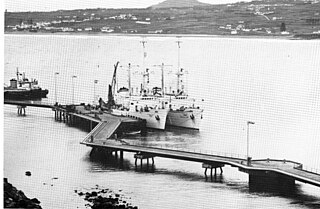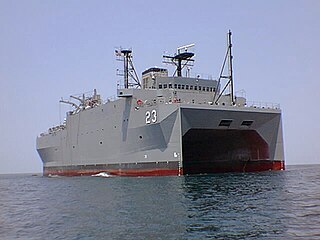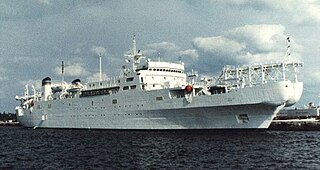
USNS Mercy (T-AH-19) is the lead ship of her class of hospital ships in non-commissioned service with the United States Navy. Her sister ship is USNS Comfort (T-AH-20). She is the third US Navy ship to be named for the virtue mercy. In accordance with the Geneva Conventions, Mercy and her crew do not carry any offensive weapons, though defensive weapons are available.

USS Cleveland (LPD-7), an Austin-class amphibious transport dock, was the third ship of the United States Navy to be named for the city in Ohio. Her keel was laid down at Ingalls Shipbuilding of Pascagoula, Mississippi. She was launched on 7 May 1966, and was commissioned on 21 April 1967 at Norfolk, Virginia. At the time of decommissioning, she was the third-oldest commissioned ship in the US Navy, behind USS Constitution and USS Enterprise.

Military Sealift Command (MSC) is an organization that controls the replenishment and military transport ships of the United States Navy. Military Sealift Command has the responsibility for providing sealift and ocean transportation for all US military services as well as for other government agencies. It first came into existence on 9 July 1949 when the Military Sea Transportation Service (MSTS) became solely responsible for the Department of Defense's ocean transport needs. The MSTS was renamed the Military Sealift Command in 1970.

USNS Comfort (T-AH-20) is a Mercy-class hospital ship of the United States Navy.

United States Naval Ship (USNS) is the prefix designation given to non-commissioned ships that are property of the United States Navy (USN).

The National Oceanic and Atmospheric Administration (NOAA) operates a wide variety of specialized ships and aircraft to carry out NOAA's environmental and scientific missions.

USNS Redstone, designated T‑AGM‑20, was a tracking ship assigned to Apollo space mission support under the control of the Eastern Range. For a brief time during conversion the ship was named Johnstown with the designation AGM‑20.

USNS Neptune (ARC-2), was the lead ship in her class of cable repair ships in U.S. Naval service. The ship was built by Pusey & Jones Corp. of Wilmington, Delaware, Hull Number 1108, as the USACS William H. G. Bullard named for Rear Adm. William H. G. Bullard. She was the first of two Maritime Commission type S3-S2-BP1 ships built for the US Army Signal Corps near the end of World War II. The other ship was the Albert J. Myer, which later joined her sister ship in naval service as the USNS Albert J. Myer (T-ARC-6).

USNS Able (T-AGOS-20) is a Victorious-class oceanographic survey ship in the service of the United States Navy's Military Sealift Command.

USNS Sands (T-AGOR-6) was a Robert D. Conrad-class oceanographic research ship operated by the Military Sealift Command (MSC) for the Naval Oceanographic Office from 1965 to 1973. During that period she provided ocean-bottom information and underwater test data to the U.S. Navy and other U.S. agencies. The ship was the second naval vessel to be named for Rear Admiral Benjamin F. Sands and his son Rear Admiral James H. Sands, the first being the destroyer Sands (DD-243). The ship operated in the Atlantic on oceanographic and geophysical assignments for the Oceanographic Office and other agencies.

USNS Lynch (T-AGOR-7) was a Robert D. Conrad-class oceanographic research ship that served the United States Navy from 1965 to 1994. During that period the ship was one of the ships under the technical direction of the Naval Oceanographic Office (NAVOCEANO) operating as an Auxiliary General Oceanographic Research (AGOR) program "pool" ship for support of Navy laboratories on each coast as well as NAVOCEANO projects. Lynch was assigned to support laboratories on the East Coast.

USNS De Steiguer (T-AGOR-12) was a Robert D. Conrad-class oceanographic research ship acquired by the U.S. Navy in 1966. She was a Navy pool vessel assigned to Naval laboratories until she was transferred to the Tunisian Navy in 1992.

USNS Bartlett (T-AGOR-13) was a Robert D. Conrad-class oceanographic research ship acquired by the U.S. Navy (USN) in 1969. She was named after oceanographer Captain John R. Bartlett of the USN. Bartlett was one of the ships under the technical direction of the Naval Oceanographic Office (NAVOCEANO) operating as an Auxiliary General Oceanographic Research (AGOR) program "pool" ship for support of Navy laboratories on each coast as well as NAVOCEANO projects. The ship was first assigned to support laboratories on the West Coast with last operations in similar support on the East Coast and Atlantic.

USNS Hayes (T-AGOR-16/T-AG-195) was a Hayes-class oceanographic research ship acquired by the U.S. Navy in 1971. In 1992 she was reconfigured as an acoustics research ship and assigned to the Navy's program of acoustic noise reduction for submarines.

USNS Victorious (T-AGOS-19) is a Victorious-class ocean surveillance ship which was acquired by the U.S. Navy in 1991 and assigned to the Military Sealift Command (MSC) Special Missions Program.

USNS Loyal (T-AGOS-22) is a Victorious-class ocean surveillance ship acquired by the U.S. Navy in 1993 and assigned to the Navy's Special Missions Program.

USNS Impeccable (T-AGOS-23) is an Impeccable-class ocean surveillance ship acquired by the U.S. Navy in 2001 and assigned to Military Sealift Command's Special Missions Program.

USNS Zeus (T-ARC-7) is the first cable ship specifically built for the United States Navy. Though planned to be the first of two ships of her class, the second ship was not built, leaving Zeus as the only ship of her class. She is capable of laying 1,000 miles (1,600 km) of cable at depths of up to 9,000 feet (2,700 m).


















